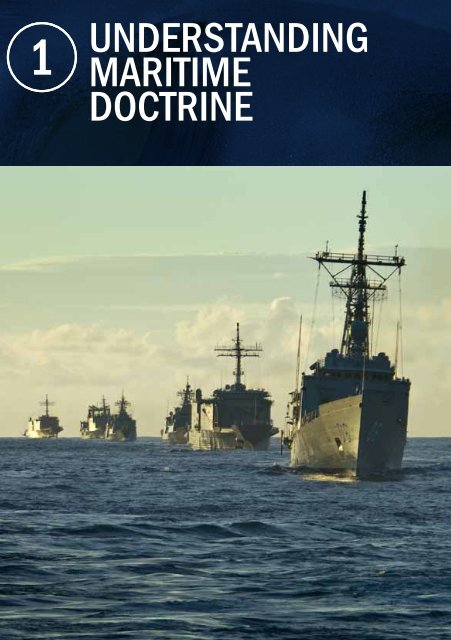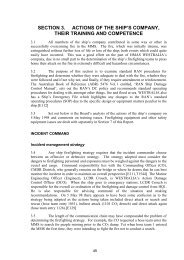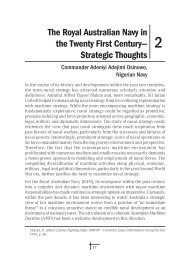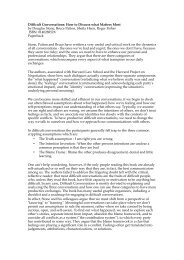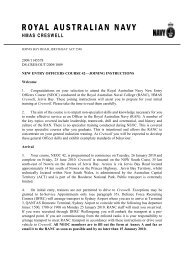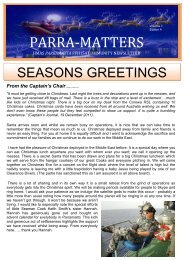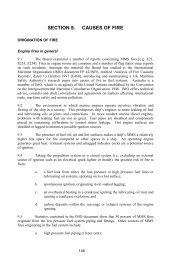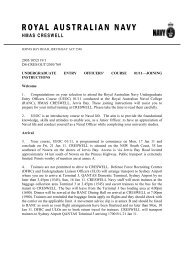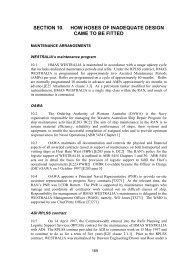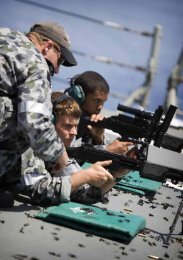UNDERSTANDING MARITIME DOCTRINE - Royal Australian Navy
UNDERSTANDING MARITIME DOCTRINE - Royal Australian Navy
UNDERSTANDING MARITIME DOCTRINE - Royal Australian Navy
Create successful ePaper yourself
Turn your PDF publications into a flip-book with our unique Google optimized e-Paper software.
1 <strong>UNDERSTANDING</strong><br />
<strong>MARITIME</strong><br />
<strong>DOCTRINE</strong>
• Maritime doctrine contains the principles by which naval<br />
forces guide their actions in support of national objectives.<br />
• Maritime doctrine is derived from hard won national and<br />
international experience gathered over many years.<br />
• Comprehensive maritime doctrine is a key element of the<br />
<strong>Royal</strong> <strong>Australian</strong> <strong>Navy</strong>’s capability.<br />
the PurPose of maritime doctrine<br />
Military doctrine contains the fundamental principles by which military<br />
forces guide their actions in support of national objectives. It helps<br />
planners and commanders approach dangerous, chaotic and unfamiliar<br />
situations with clarity of thought. It is based on rigorous analysis and a<br />
comprehensive understanding of the history of human conflict and national<br />
military experience. In effect, military doctrine provides a basis for action<br />
founded upon knowledge.<br />
Maritime doctrine is that component of military doctrine which sustains the<br />
employment of armed forces at and from the sea. This definition recognises<br />
the inherently joint nature of maritime operations and the fact that these<br />
operations are of use only so far as they can affect the course of a campaign,<br />
whether directly or indirectly. This book, <strong>Australian</strong> Maritime Doctrine: RAN<br />
Doctrine 1, explains the key concepts for the conduct of successful maritime<br />
operations. At a fundamental level it explains why Australia has a navy.<br />
the origins of australian maritime doctrine<br />
One of the principal themes of the <strong>Royal</strong> <strong>Australian</strong> <strong>Navy</strong>’s (RAN) doctrinal<br />
experience is that for most of its history its practices have been largely<br />
international. As the <strong>Navy</strong> of a medium power, and one which had its<br />
roots in the <strong>Royal</strong> <strong>Navy</strong> (RN) and has since frequently operated as part of<br />
alliance forces, the RAN has had no need to develop its doctrine wholly<br />
from first principles. Rather more than air forces and considerably more<br />
than armies, almost all modern navies operate from a very large base of<br />
shared international doctrine, allowing a level of mutual understanding<br />
that also manifests itself at much higher levels of command. For example,<br />
all of Australia’s allies at sea operate with Allied Tactical Publication 1 as<br />
a standard reference when manoeuvring and communicating with each<br />
other. Most friendly navies have access to earlier but still valid versions of<br />
the same document, while those that do not are able to use an expurgated<br />
version which allows any warship to communicate and manoeuvre safely<br />
with another. Replenishment at sea is also a generally shared skill that is the<br />
1<br />
1
australian maritime doctrine<br />
2<br />
result of the extensive development, practice and dissemination of agreed<br />
allied procedures since the end of World War II. Today there are more than<br />
thirty navies with which <strong>Australian</strong> warships can safely conduct underway<br />
replenishment with little or no notice. Thus, <strong>Australian</strong> maritime doctrine<br />
is a synthesis - and not just in a joint sense - of national effort with that<br />
derived from the country’s major allies and a wide range of other sources.<br />
Replenishment at sea is a skill shared by many navies,<br />
often allowing the RAN to extend its reach and persistence<br />
beyond the limitations of our own national force structure.<br />
A second theme of Australia’s maritime doctrine is one of complexity.<br />
The fundamentals of maritime doctrine contain many different elements;<br />
components which include factors not clearly related to conflict. These range<br />
widely. One example is that there are logistics and maintenance procedures<br />
which combine to determine whether warships are capable of extended and<br />
wide ranging activities, or whether they must confine themselves to coastal<br />
operations. Another is that the RAN ascribes to and has developed for its<br />
own use the concepts of ship navigation and pilotage laid down within the<br />
RN’s Manual of Navigation. These give it a capacity for operations in shallow<br />
water and within littoral regions that some other navies might hesitate to<br />
attempt. Thus, an activity related ostensibly to the safe passage of ships<br />
has direct implications for the <strong>Navy</strong>’s combat potential.
Iraq War, 2003<br />
the leVels of maritime doctrine<br />
understanding maritime doctrine<br />
In the lead up to combat operations against Iraq in March 2003,<br />
<strong>Australian</strong> warships consistently operated in the difficult shallow waters<br />
off the Iraqi coast while enforcing a long running economic sanctions<br />
campaign on behalf of the United Nations. By maintaining a sustained<br />
overt presence close inshore they were better able to intercept<br />
smugglers, while at the same time building up a detailed picture of local<br />
civil and military activities. This experience proved of immense value<br />
when combat operations began, allowing for better understanding of<br />
changes in Iraqi activity and movement patterns, and more effective<br />
support for coalition forces operating ashore.<br />
<strong>Australian</strong> Defence Force (ADF) doctrine is a hierarchy of capstone<br />
doctrine, philosophical doctrine, application doctrine and procedural<br />
doctrine. Although these different levels of doctrine bear some relation<br />
to the levels of command – strategic, operational and tactical – the point<br />
at which one level is subsumed by another is rarely clear. That maritime<br />
warfare does not readily allow for clear distinctions between these levels<br />
of command further complicates the issue. Elements of procedural doctrine<br />
can have fundamental implications for every other level, just as changes<br />
in philosophical doctrine will have ramifications elsewhere.<br />
Application and Procedural Doctrine<br />
Application and procedural doctrine, which relate to the operational and<br />
tactical levels and the detailed mechanics of operations at sea, have a long<br />
professional history, starting with the RN’s Fighting Instructions of 1672.<br />
The RAN employed the modern British versions of Fighting Instructions<br />
as a primary doctrinal source for the operational and tactical levels of<br />
warfare until well into the 1970s. Other important sources of guidance<br />
for operations and tactics were found in a range of North Atlantic Treaty<br />
Organization (NATO), United States (US) <strong>Navy</strong> and allied publications to<br />
which Australia had access. In the case of operations with the US and New<br />
Zealand under ANZUS and with Singapore, Malaysia, New Zealand and the<br />
United Kingdom under the Five Power Defence Arrangements, considerable<br />
effort has gone into the development of mutually agreed procedures and<br />
tactics. Evolution of these procedures continues, constantly validated by<br />
regular multinational exercises, and providing the basis for coordinated<br />
multinational and combined operations in the event of contingencies.<br />
3
australian maritime doctrine<br />
4<br />
When Australia’s strategic situation demanded a more self-reliant approach,<br />
the need for guidance tailored to <strong>Australian</strong> circumstances was met by<br />
the 1972 classified publication, <strong>Australian</strong> Maritime Doctrine and Fighting<br />
Instructions. Pared down to focus on the tactical level, this was renamed<br />
<strong>Australian</strong> Fleet Tactical Instructions (AFTI) in the late 1970s. Although<br />
AFTI remained under the editorial guidance of the RAN’s Fleet Command, it<br />
transmuted in 1994 into <strong>Australian</strong> Maritime Tactical Instructions, thereby<br />
highlighting the joint nature of maritime operations and the extent to which<br />
it received <strong>Royal</strong> <strong>Australian</strong> Air Force (RAAF) and <strong>Australian</strong> Army input.<br />
The more recent issue of the comprehensive ‘<strong>Australian</strong> Defence Doctrine<br />
Publication’ (ADDP) series, and in particular ADDP 3.0 Operations, has<br />
furthered inter-Service linkages at the operational level.<br />
Higher Level Doctrine<br />
Capstone and philosophical doctrine have not enjoyed so long a formal<br />
existence as application and procedural doctrine, particularly those<br />
discussing maritime and naval affairs. However, they are vitally important<br />
in many ways. Higher level doctrine has educational purposes in addition to<br />
its direct relevance to the employment of military force. It not only serves<br />
to educate and motivate personnel and improve their understanding of the<br />
roles and functions of their services, but can also be used to inform those<br />
within government and the wider community of the varied ways in which<br />
military forces can be used by the nation in exercising its national power.<br />
Although the philosophers of land warfare might be said to date back<br />
several thousand years, the first comprehensive analyses of maritime<br />
strategic doctrine in the Western world date only to the late 19th century.<br />
Works such as The Influence of Sea Power Upon History 1660-1783 by<br />
the American Rear Admiral Alfred Thayer Mahan (1840-1914) and Some<br />
Principles of Maritime Strategy by the British historian Sir Julian Corbett<br />
(1854-1922) had particular impact.<br />
Later in the 20th century there were increasingly sophisticated contributions<br />
from France in the work of Admiral Raoul Castex (1878-1968) in the 1930s<br />
and from the former Soviet Union by Admiral Sergei Gorshkov (1910-88) in<br />
the 1970s. These joined continuing efforts by British and American analysts<br />
to define maritime strategic concepts and match them to contemporary<br />
requirements. The British Naval War Manual (the original BR 1806 – the<br />
RN’s capstone doctrinal publication) which derived from 1921 and 1925<br />
versions, was in successive iterations (1948, 1958 and 1969) the principal<br />
source of higher level doctrine for many of the Commonwealth navies,<br />
including the RAN, in the period after World War II.
understanding maritime doctrine<br />
<strong>Australian</strong> Maritime Doctrine draws on a wide variety of sources.<br />
The end of the Cold War in the early 1990s served as the impetus for an<br />
explosion of formal doctrine as Western navies searched for new roles<br />
and justification in the absence of a great power competitor. This work<br />
fundamentally reinforced longstanding maritime concepts and tasks,<br />
some of which had received too little emphasis within the context of 20th<br />
century wars. The body of higher level maritime strategic work has been<br />
extended further by contemporary thinkers and writers such as Professors<br />
Ken Booth, Colin Gray, Eric Grove, John Hattendorf and Geoffrey Till.<br />
Within Australia, much pioneering work was done by Alan Robertson and<br />
Vernon Parker in the 1970s and this has since been carried forward by<br />
Sam Bateman, Jack McCaffrie, James Goldrick and others. The ‘Further<br />
Reading’ section provides a chronological selection of some of the more<br />
important works in maritime strategy and doctrine.<br />
5
australian maritime doctrine<br />
6<br />
Maritime doctrine is derived from the hard won<br />
experience of those who have gone before.<br />
As the RAN’s capstone doctrinal publication, <strong>Australian</strong> Maritime Doctrine<br />
draws on all these sources and many others. It stands at the summit of<br />
<strong>Australian</strong> naval doctrinal effort and fits alongside such publications as<br />
Land Warfare Doctrine (LWD) 1 - The Fundamentals of Land Warfare and<br />
<strong>Australian</strong> Air Publication (AAP) 1000-D - The Air Power Manual, as well<br />
as the major elements of the <strong>Australian</strong> Defence Doctrine Publication<br />
series, in particular ADDP-D - Foundations of <strong>Australian</strong> Military Doctrine.<br />
This book is designed to be read not only by those in the <strong>Navy</strong> and other<br />
elements of the ADF who have a direct professional concern, but by all<br />
those with an interest in and a concern for the issues of <strong>Australian</strong> security<br />
and maritime affairs.
understanding maritime doctrine<br />
Ship visits serve as a visible demonstration of Australia’s<br />
interest in strengthening international security cooperation.<br />
7


